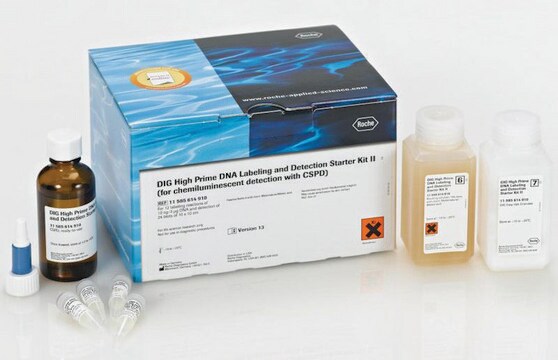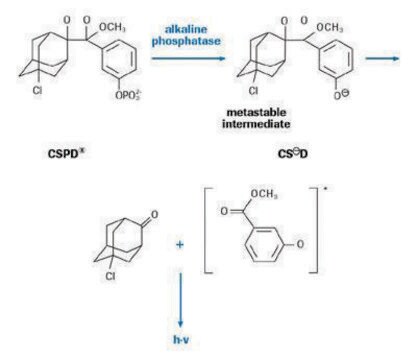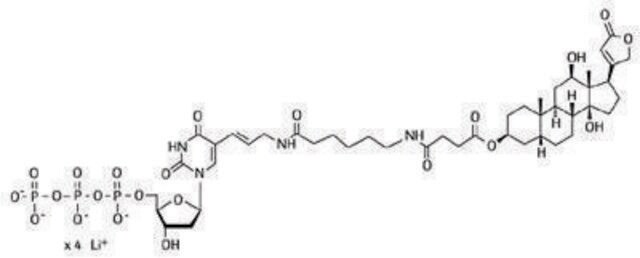11175033910
Roche
DIG DNA Labeling Kit
sufficient for 40 labeling reactions, kit of 1 (7 components), suitable for hybridization
Sinonimo/i:
dig, dna labeling kit, dig
About This Item
Prodotti consigliati
impiego
sufficient for 40 labeling reactions
Livello qualitativo
Confezionamento
kit of 1 (7 components)
Produttore/marchio commerciale
Roche
Caratteristiche più verdi
Designing Safer Chemicals
Learn more about the Principles of Green Chemistry.
sustainability
Greener Alternative Product
tecniche
hybridization: suitable
Categoria alternativa più verde
, Aligned
Temperatura di conservazione
−20°C
Descrizione generale
Specificità
Applicazioni
- All types of filter hybridization according to our standard protocol given in the pack insert of the special hybridization solution DIG Easy Hyb.
- Single-copy gene detection in total genomic DNA, even from organisms with high complexity, for example, human, barley, and wheat.
- In situ hybridizations
Confezionamento
Qualità
Specifiche
Sensitivity and specificity: A single-copy human gene (tPA gene) is detected with a DIG-labeled probe in a Southern blot of 1μg digested human placenta DNA.
Principio
Note:
- The use of the alkali-labile form of DIG-11-dUTP enables easier and more efficient stripping of blots for rehybridization experiments with a second DIG-labeled probe.
- DNA probe, labeled with DIG-11-dUTP, alkali-labile must not be denatured using NaOH, but can be denatured by boiling in a waterbath.
Altre note
Solo come componenti del kit
- Unlabeled Control DNA 1 100 µg/ml
- Unlabeled Control DNA 2 100 µg/ml
- DNA Dilution Buffer
- DIG-labeled Control DNA 5.2 µg/ml
- Hexanucleotide Mix 10x concentrated
- dNTP Labeling Mixture 10x concentrated
- Klenow Enzyme, Labeling grade 2 U/µl
Codice della classe di stoccaggio
12 - Non Combustible Liquids
Classe di pericolosità dell'acqua (WGK)
WGK 1
Punto d’infiammabilità (°F)
does not flash
Punto d’infiammabilità (°C)
does not flash
Certificati d'analisi (COA)
Cerca il Certificati d'analisi (COA) digitando il numero di lotto/batch corrispondente. I numeri di lotto o di batch sono stampati sull'etichetta dei prodotti dopo la parola ‘Lotto’ o ‘Batch’.
Possiedi già questo prodotto?
I documenti relativi ai prodotti acquistati recentemente sono disponibili nell’Archivio dei documenti.
I clienti hanno visto anche
Articoli
Digoxigenin (DIG) labeling methods and kits for DNA and RNA DIG probes, random primed DNA labeling, nick translation labeling, 5’ and 3’ oligonucleotide end-labeling.
Il team dei nostri ricercatori vanta grande esperienza in tutte le aree della ricerca quali Life Science, scienza dei materiali, sintesi chimica, cromatografia, discipline analitiche, ecc..
Contatta l'Assistenza Tecnica.








